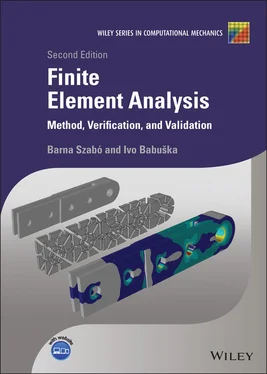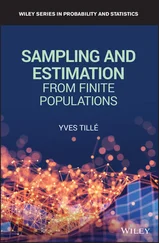2 Chapter 2Figure 2.1 Control volume and notation for heat conduction.Figure 2.2 Notation for Example 2.2.Figure 2.3 Example 2.3: The solution u of (a) the periodic problem, (b) the ...Figure 2.4 Notation for two‐dimensional domains.Figure 2.5 Example 2.4: The solution domain and finite element mesh (mm).Figure 2.6 Control volume and notation for heat conduction in 2D.Figure 2.7 Notation for stress components.Figure 2.8 Spring boundary condition. Schematic representation.Figure 2.9 Symmetry and antisymmetry of vectors in two dimensions.Figure 2.10 Notation.Figure 2.11 Virtual displacements corresponding to (a) σ 11and (b) σ ...Figure 2.12 Rigid body constraints. Notation.Figure 2.13 Example 2.7. NotationFigure 2.14 Notation.Figure 2.15 Notation.Figure 2.16 Notation for Exercise 2.7.
3 Chapter 3Figure 3.1 Standard quadrilateral and triangular elements  and
and  .Figure 3.2 Trunk space. Illustration of spanning sets for
.Figure 3.2 Trunk space. Illustration of spanning sets for  ,
,  and
and  .Figure 3.3 Product space. Illustration of spanning set for the space
.Figure 3.3 Product space. Illustration of spanning set for the space  .Figure 3.4 Hierarchic shape functions for quadrilateral elements. Trunk spac...Figure 3.5 Isoparametric quadrilateral and triangular elements.Figure 3.6 Notation for (a) the standard triangular element and (b) quarter‐...Figure 3.7 Quadrilateral element with one curved side.Figure 3.8 Quadrilateral elements bounded by circular segments.Figure 3.9 The standard tetrahedral and pentahedral elements
.Figure 3.4 Hierarchic shape functions for quadrilateral elements. Trunk spac...Figure 3.5 Isoparametric quadrilateral and triangular elements.Figure 3.6 Notation for (a) the standard triangular element and (b) quarter‐...Figure 3.7 Quadrilateral element with one curved side.Figure 3.8 Quadrilateral elements bounded by circular segments.Figure 3.9 The standard tetrahedral and pentahedral elements  and
and  .Figure 3.10 Meshing of a spherical surface with 202 triangular elements.Figure 3.11 Nodal forces associated with the 8‐node quadrilateral element. N...Figure 3.12 Example 3.3. Notation.Figure 3.13 Example 3.3. The smallest solution domain.
.Figure 3.10 Meshing of a spherical surface with 202 triangular elements.Figure 3.11 Nodal forces associated with the 8‐node quadrilateral element. N...Figure 3.12 Example 3.3. Notation.Figure 3.13 Example 3.3. The smallest solution domain.
4 Chapter 4Figure 4.1 Reentrant corner. NotationFigure 4.2 The L‐shaped domain with a circular cut‐out. (a) Notation. (b) Th...Figure 4.3 The L‐shaped domain with a circular cut‐out (  ). Comparison of tw...Figure 4.4 The L‐shaped domain. (a) Notation, (b) radically graded 27‐elemen...Figure 4.5 The L‐shaped domain. Comparison of three discretization schemes. ...Figure 4.6 The L‐shaped domain with a circular cut‐out. (a) 18‐element mesh,...Figure 4.7 Definition of
). Comparison of tw...Figure 4.4 The L‐shaped domain. (a) Notation, (b) radically graded 27‐elemen...Figure 4.5 The L‐shaped domain. Comparison of three discretization schemes. ...Figure 4.6 The L‐shaped domain with a circular cut‐out. (a) 18‐element mesh,...Figure 4.7 Definition of  .Figure 4.8 Example 4.2: The first two normalized eigenfunctions.Figure 4.9 Multi‐material interface, notation.Figure 4.10 Example 4.3. (a) Notation. (b) Value of the determinant of the m...Figure 4.11 The Fichera domain, 189‐element mesh. (a) Uniform mesh:
.Figure 4.8 Example 4.2: The first two normalized eigenfunctions.Figure 4.9 Multi‐material interface, notation.Figure 4.10 Example 4.3. (a) Notation. (b) Value of the determinant of the m...Figure 4.11 The Fichera domain, 189‐element mesh. (a) Uniform mesh:  ,
,  ,
,  ....Figure 4.12 The Laplace problem on the Fichera domain. Comparison of three d...Figure 4.13 A problem of elasticity on an L‐shaped domain. Comparison of thr...Figure 4.14 (a) A typical compact tension test specimen. (b) A typical finit...Figure 4.15 One quarter of a compact tension test specimen. (a) Mesh detail,...Figure 4.16 (a) Loading by a concentrated force. (b) Loading by a step funct...Figure 4.17 Poisson ratio locking. Notation.Figure 4.18 (a) Rigid circular inclusion in an infinite plate under tension....Figure 4.19 Example 4.5. Rigid circular inclusion. The sum of normal stresse...Figure 4.20 Example 4.7. (a) Notation. (b) Isometric view and finite element...Figure 4.21 Example 4.7. Point convergence.Figure 4.22 Composite ring. Notation.Figure 4.23 Divergence of the maximum principal stress. The results were obt...
....Figure 4.12 The Laplace problem on the Fichera domain. Comparison of three d...Figure 4.13 A problem of elasticity on an L‐shaped domain. Comparison of thr...Figure 4.14 (a) A typical compact tension test specimen. (b) A typical finit...Figure 4.15 One quarter of a compact tension test specimen. (a) Mesh detail,...Figure 4.16 (a) Loading by a concentrated force. (b) Loading by a step funct...Figure 4.17 Poisson ratio locking. Notation.Figure 4.18 (a) Rigid circular inclusion in an infinite plate under tension....Figure 4.19 Example 4.5. Rigid circular inclusion. The sum of normal stresse...Figure 4.20 Example 4.7. (a) Notation. (b) Isometric view and finite element...Figure 4.21 Example 4.7. Point convergence.Figure 4.22 Composite ring. Notation.Figure 4.23 Divergence of the maximum principal stress. The results were obt...
5 Chapter 5Figure 5.1 Rectangular beam in bending. Notation.Figure 5.2 The main elements of numerical simulation.Figure 5.3 Notation: (a) Truss element, (b) 3‐node plane stress or plane str...Figure 5.4 The main elements of finite element modeling.Figure 5.5 FEA timeline.Figure 5.6 The Girkmann problem. Notation.Figure 5.7 Lug problem. Notation.Figure 5.8 Surrogate problem. Notation.Figure 5.9 (a) Three‐dimensional contact problem. 50 pentahedral and 108 hex...Figure 5.10 Finite element mesh consisting of 2227 triangles. The constraine...Figure 5.11 Average displacement of the perimeter of the 25 mm diameter hole...Figure 5.12 Nodal forces. Notation.Figure 5.13 Coil spring.Figure 5.14 Solution domain and finite element mesh in the interval  .Figure 5.15 Contours of the von Mises stress (MPa) on a 60 degree segment of...
.Figure 5.15 Contours of the von Mises stress (MPa) on a 60 degree segment of...
6 Chapter 6Figure 6.1 Notch‐free test coupon. The dimensions are in inches. Thickness: ...Figure 6.2 The results of fatigue experiments performed on nine notched spec...Figure 6.3 Empirical relationship between the parameters a and r for 24S‐T3 ...Figure 6.4 Predicted and empirical cumulative distribution functions for the...Figure 6.5 Predicted and empirical cumulative distribution functions for the...Figure 6.6 The results of fatigue experiments performed on nine notched spec...Figure 6.7 Relationship between notch radius and notch sensitivity factor fo...Figure 6.8 The computed βk values and the  function corresponding to
function corresponding to  Figure 6.9 24S‐T3 aluminum alloy: Combined qualified test records for the ni...Figure 6.10 (a) Specimen used in validation experiments. (b) Contours of von...Figure 6.11 Outcomes of axial, torsion and combined in‐phase fatigue experim...Figure 6.12 Survival function corresponding to
Figure 6.9 24S‐T3 aluminum alloy: Combined qualified test records for the ni...Figure 6.10 (a) Specimen used in validation experiments. (b) Contours of von...Figure 6.11 Outcomes of axial, torsion and combined in‐phase fatigue experim...Figure 6.12 Survival function corresponding to  ksi. Outcomes of combined i...Figure 6.13 Nominal stresses in experiments 1 and 2.Figure 6.14 Posterior pdf corresponding to three successes in three trials....Figure 6.15 Example 2: Prior and posterior pdfs.Figure 6.16 Ideal posterior pdfs corresponding to
ksi. Outcomes of combined i...Figure 6.13 Nominal stresses in experiments 1 and 2.Figure 6.14 Posterior pdf corresponding to three successes in three trials....Figure 6.15 Example 2: Prior and posterior pdfs.Figure 6.16 Ideal posterior pdfs corresponding to  ideal data points,
ideal data points,  .Figure 6.17 Schematic representation of the validation process.
.Figure 6.17 Schematic representation of the validation process.
Читать дальше

 and
and  .Figure 3.2 Trunk space. Illustration of spanning sets for
.Figure 3.2 Trunk space. Illustration of spanning sets for  ,
,  and
and  .Figure 3.3 Product space. Illustration of spanning set for the space
.Figure 3.3 Product space. Illustration of spanning set for the space  .Figure 3.4 Hierarchic shape functions for quadrilateral elements. Trunk spac...Figure 3.5 Isoparametric quadrilateral and triangular elements.Figure 3.6 Notation for (a) the standard triangular element and (b) quarter‐...Figure 3.7 Quadrilateral element with one curved side.Figure 3.8 Quadrilateral elements bounded by circular segments.Figure 3.9 The standard tetrahedral and pentahedral elements
.Figure 3.4 Hierarchic shape functions for quadrilateral elements. Trunk spac...Figure 3.5 Isoparametric quadrilateral and triangular elements.Figure 3.6 Notation for (a) the standard triangular element and (b) quarter‐...Figure 3.7 Quadrilateral element with one curved side.Figure 3.8 Quadrilateral elements bounded by circular segments.Figure 3.9 The standard tetrahedral and pentahedral elements  and
and  .Figure 3.10 Meshing of a spherical surface with 202 triangular elements.Figure 3.11 Nodal forces associated with the 8‐node quadrilateral element. N...Figure 3.12 Example 3.3. Notation.Figure 3.13 Example 3.3. The smallest solution domain.
.Figure 3.10 Meshing of a spherical surface with 202 triangular elements.Figure 3.11 Nodal forces associated with the 8‐node quadrilateral element. N...Figure 3.12 Example 3.3. Notation.Figure 3.13 Example 3.3. The smallest solution domain. ). Comparison of tw...Figure 4.4 The L‐shaped domain. (a) Notation, (b) radically graded 27‐elemen...Figure 4.5 The L‐shaped domain. Comparison of three discretization schemes. ...Figure 4.6 The L‐shaped domain with a circular cut‐out. (a) 18‐element mesh,...Figure 4.7 Definition of
). Comparison of tw...Figure 4.4 The L‐shaped domain. (a) Notation, (b) radically graded 27‐elemen...Figure 4.5 The L‐shaped domain. Comparison of three discretization schemes. ...Figure 4.6 The L‐shaped domain with a circular cut‐out. (a) 18‐element mesh,...Figure 4.7 Definition of  .Figure 4.8 Example 4.2: The first two normalized eigenfunctions.Figure 4.9 Multi‐material interface, notation.Figure 4.10 Example 4.3. (a) Notation. (b) Value of the determinant of the m...Figure 4.11 The Fichera domain, 189‐element mesh. (a) Uniform mesh:
.Figure 4.8 Example 4.2: The first two normalized eigenfunctions.Figure 4.9 Multi‐material interface, notation.Figure 4.10 Example 4.3. (a) Notation. (b) Value of the determinant of the m...Figure 4.11 The Fichera domain, 189‐element mesh. (a) Uniform mesh:  ,
,  ,
,  ....Figure 4.12 The Laplace problem on the Fichera domain. Comparison of three d...Figure 4.13 A problem of elasticity on an L‐shaped domain. Comparison of thr...Figure 4.14 (a) A typical compact tension test specimen. (b) A typical finit...Figure 4.15 One quarter of a compact tension test specimen. (a) Mesh detail,...Figure 4.16 (a) Loading by a concentrated force. (b) Loading by a step funct...Figure 4.17 Poisson ratio locking. Notation.Figure 4.18 (a) Rigid circular inclusion in an infinite plate under tension....Figure 4.19 Example 4.5. Rigid circular inclusion. The sum of normal stresse...Figure 4.20 Example 4.7. (a) Notation. (b) Isometric view and finite element...Figure 4.21 Example 4.7. Point convergence.Figure 4.22 Composite ring. Notation.Figure 4.23 Divergence of the maximum principal stress. The results were obt...
....Figure 4.12 The Laplace problem on the Fichera domain. Comparison of three d...Figure 4.13 A problem of elasticity on an L‐shaped domain. Comparison of thr...Figure 4.14 (a) A typical compact tension test specimen. (b) A typical finit...Figure 4.15 One quarter of a compact tension test specimen. (a) Mesh detail,...Figure 4.16 (a) Loading by a concentrated force. (b) Loading by a step funct...Figure 4.17 Poisson ratio locking. Notation.Figure 4.18 (a) Rigid circular inclusion in an infinite plate under tension....Figure 4.19 Example 4.5. Rigid circular inclusion. The sum of normal stresse...Figure 4.20 Example 4.7. (a) Notation. (b) Isometric view and finite element...Figure 4.21 Example 4.7. Point convergence.Figure 4.22 Composite ring. Notation.Figure 4.23 Divergence of the maximum principal stress. The results were obt... .Figure 5.15 Contours of the von Mises stress (MPa) on a 60 degree segment of...
.Figure 5.15 Contours of the von Mises stress (MPa) on a 60 degree segment of... function corresponding to
function corresponding to  Figure 6.9 24S‐T3 aluminum alloy: Combined qualified test records for the ni...Figure 6.10 (a) Specimen used in validation experiments. (b) Contours of von...Figure 6.11 Outcomes of axial, torsion and combined in‐phase fatigue experim...Figure 6.12 Survival function corresponding to
Figure 6.9 24S‐T3 aluminum alloy: Combined qualified test records for the ni...Figure 6.10 (a) Specimen used in validation experiments. (b) Contours of von...Figure 6.11 Outcomes of axial, torsion and combined in‐phase fatigue experim...Figure 6.12 Survival function corresponding to  ksi. Outcomes of combined i...Figure 6.13 Nominal stresses in experiments 1 and 2.Figure 6.14 Posterior pdf corresponding to three successes in three trials....Figure 6.15 Example 2: Prior and posterior pdfs.Figure 6.16 Ideal posterior pdfs corresponding to
ksi. Outcomes of combined i...Figure 6.13 Nominal stresses in experiments 1 and 2.Figure 6.14 Posterior pdf corresponding to three successes in three trials....Figure 6.15 Example 2: Prior and posterior pdfs.Figure 6.16 Ideal posterior pdfs corresponding to  ideal data points,
ideal data points,  .Figure 6.17 Schematic representation of the validation process.
.Figure 6.17 Schematic representation of the validation process.










